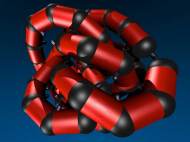Nano-machines which recreate principal activities of proteins
 A group of researchers in Austria have developed nano-machines which are able to mimic principal activities of proteins. Thanks to the Vienna Scientific Cluster (VSC), a high performance computing infrastructure, the researchers presented the first versatile and modular example of a fully artificial protein-mimetic model system. Once perfected, these artificial proteins could make a change in pharmaceutical research.
A group of researchers in Austria have developed nano-machines which are able to mimic principal activities of proteins. Thanks to the Vienna Scientific Cluster (VSC), a high performance computing infrastructure, the researchers presented the first versatile and modular example of a fully artificial protein-mimetic model system. Once perfected, these artificial proteins could make a change in pharmaceutical research.
Proteins are the fundamental building blocks of all known living organism from our planet. Often referred to as “molecular machines”, proteins can take part of and perform large number complex bio-molecular processes. There are 20 different types of amino acids that can be combined to make a protein, and hundreds or thousands of amino acids connect in long chains to define proteins in a process called translation. The sequence of amino acids determines each protein’s 3D structure and its specific function.
“Imitating these astonishing bio-mechanical properties of proteins and transferring them to a fully artificial system is our long term objective”, said Ivan Coluzza from the Faculty of Physics of the University of Vienna, who works on this project together with colleagues of the University of Natural Resources and Life Sciences Vienna.
The team devised the first example of a fully artificial bio-mimetic model system capable of spontaneously self-knotting into a target structure – thus mimicking proteins. With help from VSC, they used intensive computer simulations to reverse engineer proteins by focusing on the key elements that give them the ability to execute the program written in the genetic code.
The team is using specially functionalized nanoparticles to actually build these artificial proteins in the laboratory. Sequence determined by the computer simulations will serve as templates for particles which will be connected into chains that will fold into the desired shapes. These nanostructures could then be used as drug delivery vehicles and as more stable enzyme-like catalysts.
For more information, read the paper published in the Physical Review Letters: “Sequence Controlled Self-Knotting Colloidal Patchy Polymers”.









Leave your response!